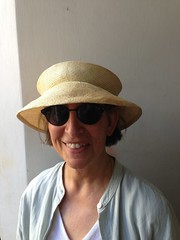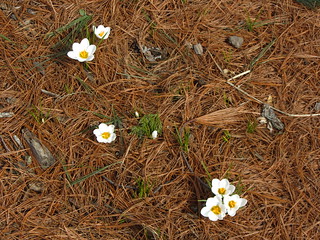
I'm a writer, publishing both as SJ Rozan and, with Carlos Dews, as Sam Cabot. (I'm Sam, he's Cabot.) Here you can find links to my almost-daily blog posts, including the Saturday haiku I've been doing for years. BUT the blog itself has moved to my website. If you go on over there you can subscribe and you'll never miss a post. (Miss a post! A scary thought!) Also, I'll be teaching a writing workshop in Italy this summer -- come join us!
Read/Post Comments (1)

Xi'an
Was in Xi'an for three days, including the earthquake. You've heard about that; here are some other observations.
Xi'an's greatly shncged since I was here ten years ago. Then, it was a dusty, gritty city of 5 million, mostly a petrochemical industry town which also happened to be the closest city to the teracotta army. The army itself was housed in its archeological pit, where the dig was on-going, roofed but not enclosed at the end of a long hot parking lot. Now Xi'an's grown to 7 million, still in industry but, like a lot of China, having discovered tourism as an industry. The warriors have been enclosed, though the dig continues; the parking lot's been replaced with a huge garden, through which you walk and walk and walk to get there, and then you walk back through a shopping plaza where you can buy mini-warriors, chariots, postcards... The garden's a great thing, part of China's attempt to reclaim land the desert seems to be claiming at up to 15 feet a year. And the plaza's probably unavoidable. And enclosing the art is also a good idea. Coming face-to-face with the terra cotta army just didn't have the impact it did on me the first time, though. Maybe that's really because it was the second time; or maybe it's because the whole experience is now very polished, and so the sense of sudden encounter is gone.
In Xi'an itself, the Muslim quarter has become completely a matter of tourist shops, and the Drum Tower, the Bell Tower, and the city wall are all outlined in neon at night. Boy, the Chinese love their neon. Every ancient structure is neoned within an inch of its life, and no commercial venture worth anything is without a giant multicolor neon sign.
The Shaanxi Provincial Museum, on the other hand, is Asian art geek heaven, more Tang horses and camels than I'd have believed. And the tomb of a Han emperor with its 1/4 scale clay figures of people -- including a detachment of all-female cavalry -- and animals, was astounding.
And of course the food continues to be great.
Xi'an's greatly shncged since I was here ten years ago. Then, it was a dusty, gritty city of 5 million, mostly a petrochemical industry town which also happened to be the closest city to the teracotta army. The army itself was housed in its archeological pit, where the dig was on-going, roofed but not enclosed at the end of a long hot parking lot. Now Xi'an's grown to 7 million, still in industry but, like a lot of China, having discovered tourism as an industry. The warriors have been enclosed, though the dig continues; the parking lot's been replaced with a huge garden, through which you walk and walk and walk to get there, and then you walk back through a shopping plaza where you can buy mini-warriors, chariots, postcards... The garden's a great thing, part of China's attempt to reclaim land the desert seems to be claiming at up to 15 feet a year. And the plaza's probably unavoidable. And enclosing the art is also a good idea. Coming face-to-face with the terra cotta army just didn't have the impact it did on me the first time, though. Maybe that's really because it was the second time; or maybe it's because the whole experience is now very polished, and so the sense of sudden encounter is gone.
In Xi'an itself, the Muslim quarter has become completely a matter of tourist shops, and the Drum Tower, the Bell Tower, and the city wall are all outlined in neon at night. Boy, the Chinese love their neon. Every ancient structure is neoned within an inch of its life, and no commercial venture worth anything is without a giant multicolor neon sign.
The Shaanxi Provincial Museum, on the other hand, is Asian art geek heaven, more Tang horses and camels than I'd have believed. And the tomb of a Han emperor with its 1/4 scale clay figures of people -- including a detachment of all-female cavalry -- and animals, was astounding.
And of course the food continues to be great.
Read/Post Comments (1)
Previous Entry :: Next Entry
Back to Top